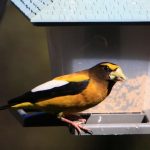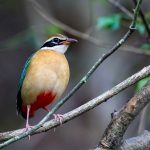Jeff Gordon and I were wandering around the seriously disturbed habitat behind the airport hotel we stayed in outside of Budapest when a bizarre mammal about the size of an opossum crossed the path in front of us. “What the #*$% was that?!?!”
It turns out it was a hedgehog, a Northern White-breasted Hedgehog to be exact. Neither of us had ever seen any species of hedgehog and it is no wonder that we were both surprised and excited to see such a cool little creature. After all, North America has no native hedgehogs and seeing something so outside of our normal experience was pretty exciting, even if the little guy quickly headed for cover and refused to show itself for Clay Taylor, who came upon the scene a minute too late. Fortunately for those who want to see what Erinaceus roumanicus looks like, an even more cooperative hedgehog showed up the next day on the shores of Lake Tisza.
But before I get further into my close encounter with a hedgehog I think it makes sense to share a bit of general hedgehog information, especially for the Americans in our audience who, like me, might not know much about them. There are seventeen species of hedgehog found across Europe, Asia, and Africa, the only places where hedgehogs are native. New Zealand has a host of hedgehogs but they are introduced.
The most familiar hedgehog to Americans is probably the European Hedgehog E. europaeus, found throughout most of western Europe and parts of northern Europe as well, though the hybrids that are often sold in American pet stores might be even more familiar. The Northern White-breasted Hedgehog in this post was once considered a subspecies of the European Hedgehog and then it was considered a subspecies of the Southern White-breasted Hedgehog E. concolor once that was split from the European Hedgehog. It was only in the 1990s that Erinaceus roumanicus was elevated to species status. It is really no wonder, then, that Jeff and I had no idea exactly what species we were looking at when we first encountered it.
Anyway, the hedgehog that we spotted at Lake Tisza appeared down a dirt track from us while we were trying to focus on a fledgling Barred Warbler. Some of the western European birders remarked upon how white it was, which makes sense considering that the European Hedgehog that they are used to is typically darker. They also remarked upon how odd it was that it was walking out in the wide open so near to us – and then it kept coming closer and closer. Best. Hedgehog. Ever.
I will say, however, that several of the European birders took offense at my saying that the hedgehog was my best bird of the trip…there were even grumblings about it being like saying a White-tailed Deer was the best bird of a trip to North America, which I think is totally different but, yeah, I get the point. Fine, my best bird was a White-backed Woodpecker, alright?
…
My week-long trip to Hungary was a familiarity trip organized by the wonderful folks at Swarovski Optik to introduce their new line of superior spotting scopes, the ATX and the STX modular telescopes. We visited Hortobágy National Park, the Bükk Hills and places in between. Many thanks to Swarovski Optik for inviting me along and letting me experience both some awesome new optics and the natural wonders of the wonderful country of Hungary.
…
………



















Comparing a hedgehog to a white-tailed deer is not quite correct. They may be equally common, but a hedgehog is not easy to see, even at night. In fact, I haven’t seen one in a year or two. During the day?! You were VERY lucky indeed.
And you have also experienced how slow they often are. After all, Jeff and you had enought time to say “What the number-star-dollar-percent was that!?”. 😉
Congrats again. Mammal encounters are always special, but true, very true, a hedgehog does not beat a White-backed Woodpecker (or Bornean Bristlehead for that matter).
@Jochen: During the day twice! And, yeah, any good look at a mammal tends to be pretty darn cool.
Excellent find! Very likely a nursing mother, if it was healthy and out and about during the day.
I agree with Jochen, hedgehogs are not common sights, although I have occasionally seen them out and about in broad daylight in busy cities.
Corey, if you don’t send me your Germany wish list anytime soon, I’ll publicly humiliate you by telling everyone just how small your scope is.
Bit late but, oh, I do lurrrrve hedgehogs, even if they are everywhere here (and suprisingly noisy at times…). I’m still always a bit suprised when they run off and show how long there legs really are!
*their, argh, embarrassed.
Hey, what were you guys doin near my uncle’s house? What were you doing in Hungary? He lives walking distance to Ferihegy (the Budapest Airport). When the local hedgehogs burrow under the street (the streets are dirt, out there) the dog goes nuts, and won’t stop barking. Were you looking for Syrian Woodpecker? They hang out on my uncle’s street, Kevekoto utca.
@Tom Miko: We were doing this. And we were probably pretty close to your uncle’s house for a night on each on each end of the trip.